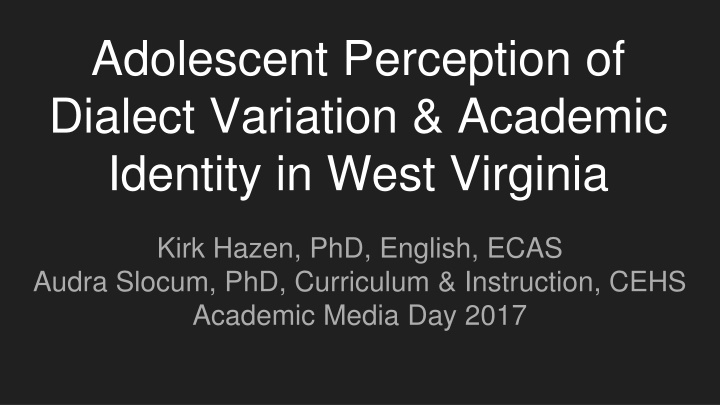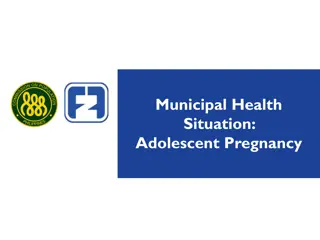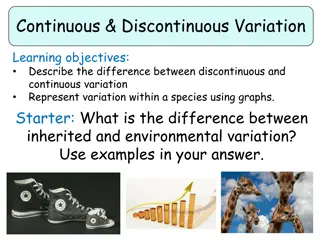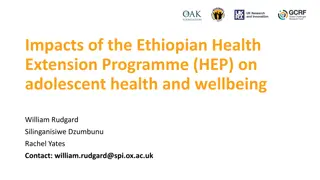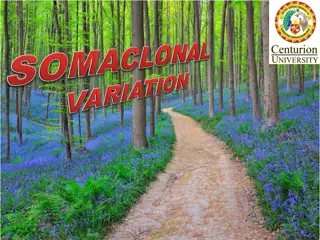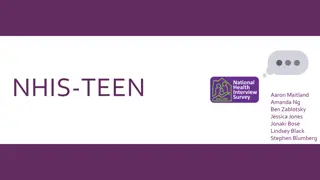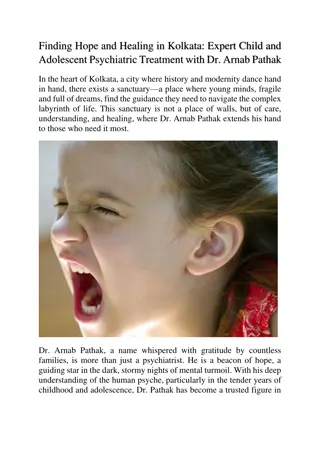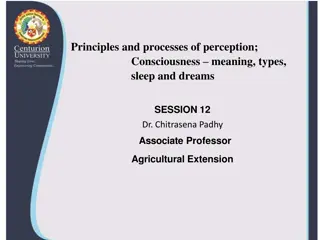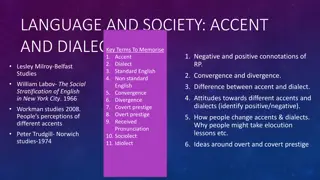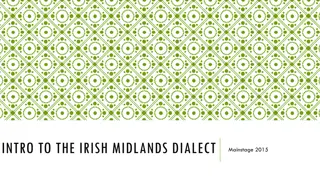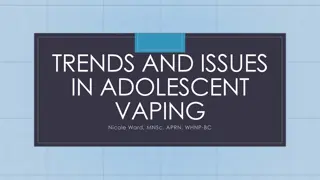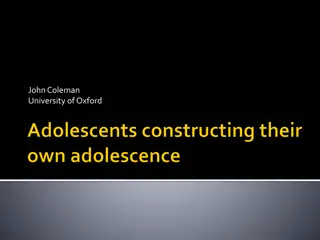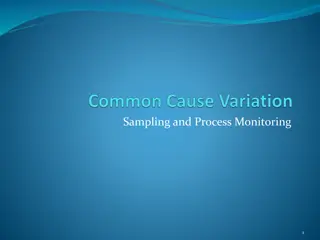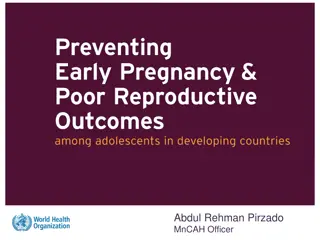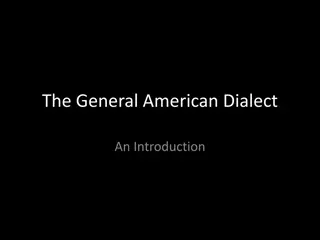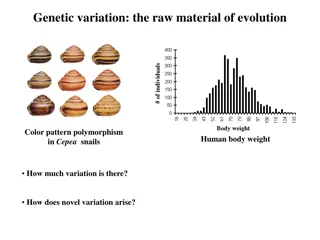Adolescent Perception of Dialect Variation in West Virginia
This study explores how adolescents in West Virginia perceive dialect variation and its impact on academic identity. Kirk Hazen, PhD in English, and Audra Slocum, PhD in Curriculum & Instruction, present findings from the West Virginia Dialect Project at Academic Media Day 2017, emphasizing the importance of integrating language scholarship with teaching, research, and outreach.
Uploaded on Oct 02, 2024 | 3 Views
Download Presentation

Please find below an Image/Link to download the presentation.
The content on the website is provided AS IS for your information and personal use only. It may not be sold, licensed, or shared on other websites without obtaining consent from the author.If you encounter any issues during the download, it is possible that the publisher has removed the file from their server.
You are allowed to download the files provided on this website for personal or commercial use, subject to the condition that they are used lawfully. All files are the property of their respective owners.
The content on the website is provided AS IS for your information and personal use only. It may not be sold, licensed, or shared on other websites without obtaining consent from the author.
E N D
Presentation Transcript
Adolescent Perception of Dialect Variation & Academic Identity in West Virginia Kirk Hazen, PhD, English, ECAS Audra Slocum, PhD, Curriculum & Instruction, CEHS Academic Media Day 2017
West Virginia Dialect Project Language scholarship integrating teaching, research, and outreach. Research: Sociolinguistic papers, and presentations, and grant proposals. Active Learning: Research Assistants learn while conducting research; some are paid through NSF funding while others work through credit hours. Service: Education for the community through talks and consulting.
Research Questions 1.In what ways are rural and urban language variation patterns diverging? 2.How do adolescent WV speakers modulate different linguistic patterns to maintain certain educational goals? 3.For younger Appalachians, do their language variation patterns reflect the traditional north/south divide or are they moving towards new regional norms? 4.Within their local educational contexts, how does adolescent Appalachians creation of social meaning from linguistic patterns influence synchronic and diachronic patterns? 5.What do these patterns mean for the students social and academic identity performance with other students and teachers?
Relevance of Research Many of the traditional patterns of English in Appalachia are quickly fading from WV. These patterns have become badges of rural identity and selectively play a role in the creation of sociolinguistic identities for today s teens. Language - how we speak - is used to mark our cultural community and is intimately tied to our identities. Schools typically enforce white, middle class cultural practices. Critique of practices outside of the white, middle-class is common Critique can create a learning environment that demands that a student make a significant and complex cultural choice to align with school or home.
Prior Research: Linguistic Change in WV Three phases: 1.A Sociolinguistic Baseline for English in Appalachia (NSF BCS-0743489) From the WV Corpus of English in Appalachia ING variation Leveled was t/d deletion 2.Phonetic Variation in Appalachia (NSF BCS-1120156) Wh/W S/Z devoicing Vowels: Southern Vowel Shift (SVS) in WV 3.Community Studies of Sociolinguistic Change in Appalachia (NSF BCS-1651003)
Demonstrative Them Singular: This, That Plural: These, Those Demonstrative them: I saw a dozen of them kids But all them young ladies though, they wanted to hold him
Oldest Speakers Demonstrative them results
The Quotative Phenomenon Quotatives: Introducing direct quotes in discourse Be like: They have just been like, Haha, you are from West Virginia. Say: I said, Pour it to it. Zero: She threw down her books, and gave me a forty-five minute lecture on "that was a blatantly sexist gesture. Other: He yelled out, Somebody dropped an Oreo!
Our current study: vowels Why study vowels Linguistically Vowels tend to change faster than consonants Systematic patterns in all languages Socially Some of the most-used markers of social meaning Salient features of different dialects Historically important: The Great Vowel Shift
WVDP Research Support 5 NSF grants (and one submitted) 7 Research Experience for Undergraduates NSF grants 1 NEH fellowship
1 3 VOWELS IN SPACE (AND NOT ON THE PAGE)
1 4 Kirk.Hazen@mail.wvu.edu @DrDialect
1 5 Kirk.Hazen@mail.wvu.edu @DrDialect
1 6 Kirk.Hazen@mail.wvu.edu @DrDialect
17 Kirk.Hazen@mail.wvu.edu @DrDialect
DIFFERENT REGIONS, DIVERGING VOWELS 1
19 Kirk.Hazen@mail.wvu.edu @DrDialect
24 Kirk.Hazen@mail.wvu.edu @DrDialect
25 Kirk.Hazen@mail.wvu.edu @DrDialect
26 Kirk.Hazen@mail.wvu.edu @DrDialect
Prior Research: Appalachian Adolescent Perceptions of Dialect Very little research in this area Enregistrement Colloquial labels: country versus proper speech Use of certain speech features for rhetorical effect Common awareness that speech features associated with the Appalachian region are also associated with poverty, deficient education, cultural backwardness , and other stereotypes of the region Lack of discussion of dialect features and rights in schools supports persistence of negative associations and limited language around dialect
National Council of Teachers of English 1974 Students Right to Their Own Language We affirm the students' right to their own language to the dialect that expresses their family and community identity, the idiolect that expresses their unique personal identity; that NCTE affirm the responsibility of all teachers of English to assist all students in the development of their ability to speak and write better whatever their dialects; that NCTE affirm the responsibility of all teachers to provide opportunities for clear and cogent expression of ideas in writing, and to provide the opportunity for students to learn the conventions of what has been called written edited American English; and that NCTE affirm strongly that teachers must have the experiences and training that will enable them to understand and respect diversity of dialects. Be it further Resolved, that, to this end, that NCTE promote classroom practices to expose students to the variety of dialects that comprise our multiregional, multiethnic, and multicultural society, so that they too will understand the nature of American English and come to respect all its dialects.
Language in Schools Language is integral to identity construction Language is a central tool of enculturation Language stigmatization is linked with other forms of cultural marginalizations Very little explicit instruction on dialects and language diversity Early research examined a home and school divide Promoted Contextual appropriateness approach to language Current research examines sophisticated patterns and purposes for adolescent language usage and their language ideologies
Research Context & Methods 4 middle schools in West Virginia 2 schools in southern WV, 1 in a town and 1 in rural community 2 schools in northern WV, 1 in a town and 1 in rural community 1 focal classroom per school 12 focal students per classroom 3 week-long visits per school over the academic year One-on-one interviews, focus group interviews, audio-recording of classroom talk, detailed observation notes.
Future Application of Research Findings Teacher Education & Professional Development Accurate sociolinguistic knowledge of dialects Providing professional development on research-based approaches to teaching about language variation and usage in spoken and written forms. Designing curriculum resources on language use, language ideology, and language prejudice in West Virginia and beyond
Thank you! We thank the NSF and ECAS for funding. & the wonderful research assistants of the WVDP. Thanks to Maggie McDonald, Illustrator. For more information on the WVDP: http://dialects.english.wvu.edu
